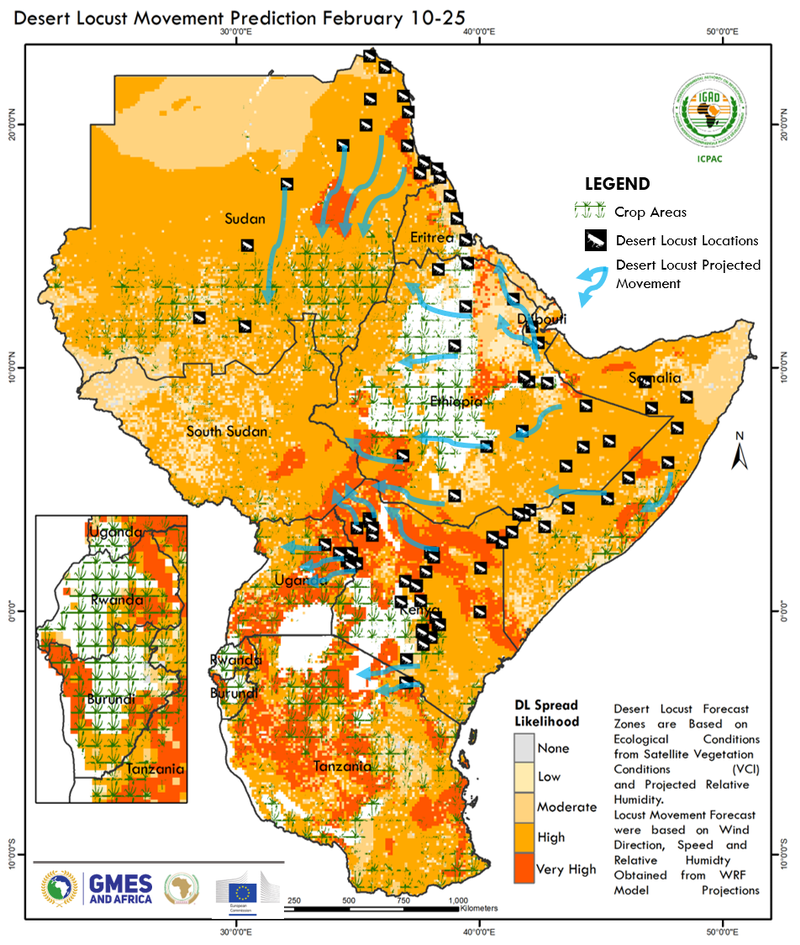Desert Locust: Upcoming cropping season at risk across East Africa
Eggs laid along migratory path expected to hatch in the coming weeks, giving ground to second round of invasion
18th February 2020, Nairobi: March to May is the main cropping season for many countries in Eastern Africa (most of Kenya, Uganda, Tanzania, southern South Sudan, southern Ethiopia and southern Somalia). The swarms of locusts, which have now spread to eight countries (Kenya, Ethiopia, Somalia, Djibouti, Uganda, Tanzania, Sudan and Eritrea), have been laying eggs along their migratory paths. The eggs are expected to hatch between March and April, posing serious risks to the upcoming cropping season. Desert locusts are expected to continue breeding and spreading during the coming months due to favorable climatic conditions (throughout the March to May rainfall season), as forecasted by ICPAC.
Desert Locust Update:
- Eastern Africa countries should brace themselves for a second round of invasion in the next one to two months.
- Under a worse-case scenario, the desert locusts will invade key production areas/bread-baskets of the region and cause significant crop losses during the March to May cropping season, and could potentially worsen the food security situation.
- Some swarms have now reached northern Tanzania and north-eastern Uganda. There is a high likelihood that swarms could reach South Sudan at any time. As swarms increase in some countries in the region (Ethiopia, Somalia and Kenya), others continue to lay eggs, and hatching is certainly underway in many places (such as in Sudan). Breeding during February will cause a further increase in hopper bands in these countries in March and April, a time of planting and growth of crops.
- Climatic and ecological conditions suitable for locust reproduction and development are very favorable in most of northwestern Kenya, eastern to central Uganda and northern to western Tanzania. These areas face the highest risk of new swarms invasion (see ICPAC Desert Locust Prediction Map).
The Food Security and Nutrition Working Group (FSNWG) stated in their recent special report on Desert Locust that “Most affected areas are currently facing Crisis (IPC Phase 3) or Stressed (IPC Phase 2) food insecurity. According to the IPC, 9.75 million people living in areas affected by desert locusts in Ethiopia, Kenya, and Somalia are currently or projected to be in a food Crisis (IPC Phase 3) or worse”. This upsurge builds on several successive shocks including climatic (consecutive poor seasons characterized by extreme droughts and/or widespread flooding), conflict, and poor macroeconomic conditions.
The IGAD Heads of State and Government during their 34th Extraordinary Summit, called for increased coordination given the fact that the locust invasion transcends the IGAD region, affecting also neighboring gulf states and countries in the Arabian Peninsula. “We call upon international and development partners to support the ongoing efforts of IGAD Member States and East Africa to fill in requisite financial, technical and logistical capacity gaps to effectively fight the locust invasion”.
“The heavy rainfall brought by the extreme positive Indian Ocean Dipole (IOD) and the unusual cyclonic activity contributed to the current Desert Locust upsurge. In 2019 the warming of the Indian Ocean led to 8 cyclones, the highest number on record so far, forming in a year over the Indian Ocean. The extreme positive IOD, one of the highest on record, led to one of the wettest October to December rainy seasons in many parts of East Africa. According to recent research, this type of extreme positive IOD events could double in frequency under a scenario of 1.5 °C warming.” said Dr. Guleid Artan, director of ICPAC.
We call for:
- Stakeholders to double control operations (ground and aerial) and coordinate efforts. The region needs to act collectively and decisively to avert a possible worsening of the food security situation.
- Development partners to continue supporting countries’ control operations (financially and technically) to safeguard the March to May cropping season.
- Countries are encouraged to voice any monitoring and control gaps for adequate interventions.
- Countries to make special arrangements that will enable control operations along, and across borders such as ground surveillance and aerial spraying.
- Communities should be capacitated to identify desert locusts and conduct possible control measures. Citizens in areas of high risk of invasion should be guided on how to report to respective authorities.
- Countries are encouraged to have toll free hotline numbers to enable citizens report issues regarding the Desert Locust invasion.
- Countries are encouraged to rapidly release adequate funds to aid the monitoring and control of the Locust, and share good practices with neighbors.
Resources
- Assessment Report on Food Security Impacts of current Desert Locust Outbreak
- Communique of the 34th extraordinary summit of IGAD heads of State and Government, February 2020 Addis Ababa, Ethiopia
- Press Conference Press Release (24th of January)

